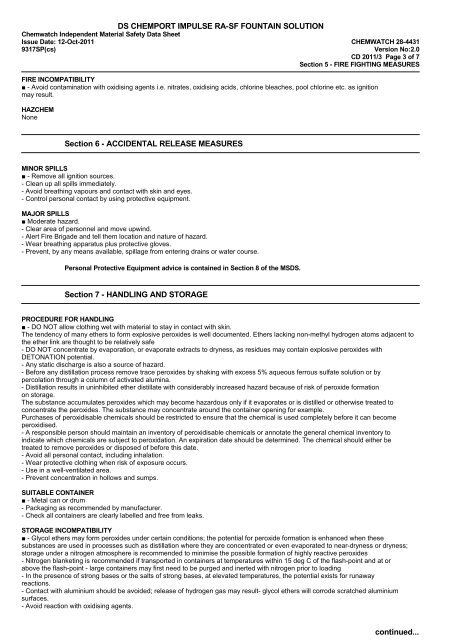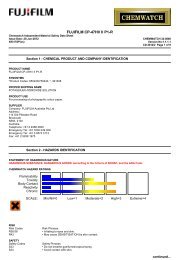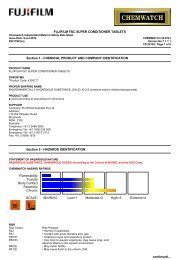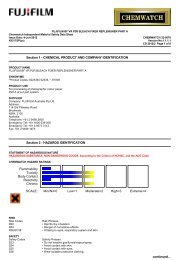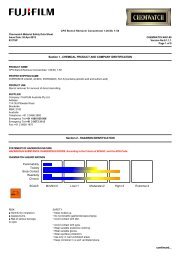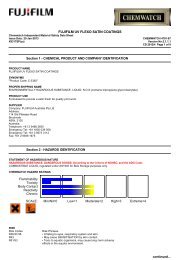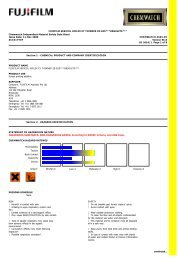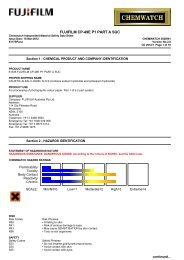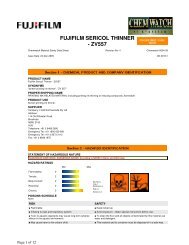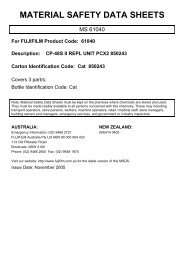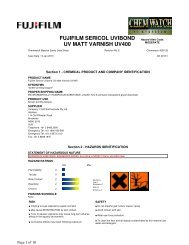ds chemport impulse ra-sf fountain solution - FUJIFILM Australia
ds chemport impulse ra-sf fountain solution - FUJIFILM Australia
ds chemport impulse ra-sf fountain solution - FUJIFILM Australia
Create successful ePaper yourself
Turn your PDF publications into a flip-book with our unique Google optimized e-Paper software.
DS CHEMPORT IMPULSE RA-SF FOUNTAIN SOLUTIONChemwatch Independent Material Safety Data SheetIssue Date: 12-Oct-2011 CHEMWATCH 28-44319317SP(cs)Version No:2.0CD 2011/3 Page 3 of 7Section 5 - FIRE FIGHTING MEASURESFIRE INCOMPATIBILITY■ - Avoid contamination with oxidising agents i.e. nit<strong>ra</strong>tes, oxidising aci<strong>ds</strong>, chlorine bleaches, pool chlorine etc. as ignitionmay result.HAZCHEMNoneSection 6 - ACCIDENTAL RELEASE MEASURESMINOR SPILLS■ - Remove all ignition sources.- Clean up all spills immediately.- Avoid breathing vapours and contact with skin and eyes.- Control personal contact by using protective equipment.MAJOR SPILLS■ Mode<strong>ra</strong>te hazard.- Clear area of personnel and move upwind.- Alert Fire Brigade and tell them location and nature of hazard.- Wear breathing appa<strong>ra</strong>tus plus protective gloves.- Prevent, by any means available, spillage from entering d<strong>ra</strong>ins or water course.Personal Protective Equipment advice is contained in Section 8 of the MSDS.Section 7 - HANDLING AND STORAGEPROCEDURE FOR HANDLING■ - DO NOT allow clothing wet with material to stay in contact with skin.The tendency of many ethers to form explosive peroxides is well documented. Ethers lacking non-methyl hydrogen atoms adjacent tothe ether link are thought to be relatively safe- DO NOT concent<strong>ra</strong>te by evapo<strong>ra</strong>tion, or evapo<strong>ra</strong>te ext<strong>ra</strong>cts to dryness, as residues may contain explosive peroxides withDETONATION potential.- Any static discharge is also a source of hazard.- Before any distillation process remove t<strong>ra</strong>ce peroxides by shaking with excess 5% aqueous ferrous sulfate <strong>solution</strong> or bypercolation through a column of activated alumina.- Distillation results in uninhibited ether distillate with conside<strong>ra</strong>bly increased hazard because of risk of peroxide formationon sto<strong>ra</strong>ge.The substance accumulates peroxides which may become hazardous only if it evapo<strong>ra</strong>tes or is distilled or otherwise treated toconcent<strong>ra</strong>te the peroxides. The substance may concent<strong>ra</strong>te around the container opening for example.Purchases of peroxidisable chemicals should be restricted to ensure that the chemical is used completely before it can becomeperoxidised.- A responsible person should maintain an inventory of peroxidisable chemicals or annotate the gene<strong>ra</strong>l chemical inventory toindicate which chemicals are subject to peroxidation. An expi<strong>ra</strong>tion date should be determined. The chemical should either betreated to remove peroxides or disposed of before this date.- Avoid all personal contact, including inhalation.- Wear protective clothing when risk of exposure occurs.- Use in a well-ventilated area.- Prevent concent<strong>ra</strong>tion in hollows and sumps.SUITABLE CONTAINER■ - Metal can or drum- Packaging as recommended by manufacturer.- Check all containers are clearly labelled and free from leaks.STORAGE INCOMPATIBILITY■ - Glycol ethers may form peroxides under certain conditions; the potential for peroxide formation is enhanced when thesesubstances are used in processes such as distillation where they are concent<strong>ra</strong>ted or even evapo<strong>ra</strong>ted to near-dryness or dryness;sto<strong>ra</strong>ge under a nitrogen atmosphere is recommended to minimise the possible formation of highly reactive peroxides- Nitrogen blanketing is recommended if t<strong>ra</strong>nsported in containers at tempe<strong>ra</strong>tures within 15 deg C of the flash-point and at o<strong>ra</strong>bove the flash-point - large containers may first need to be purged and inerted with nitrogen prior to loading- In the presence of strong bases or the salts of strong bases, at elevated tempe<strong>ra</strong>tures, the potential exists for runawayreactions.- Contact with aluminium should be avoided; release of hydrogen gas may result- glycol ethers will corrode sc<strong>ra</strong>tched aluminiumsurfaces.- Avoid reaction with oxidising agents.continued...


